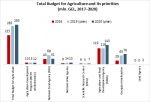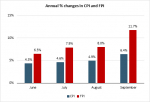Retail food prices decreased by 1.3% y/y and 0.2% m/m. Compared to the end of March, the biggest drops in prices happened in the vegetables category: eggplants are down by 11.8%; cucumbers by 11.2%; and cabbage by 5.3%.
The biggest increases were recorded for wheat flour (added 9.3%), garlic (9.0%) and tea (7.7%.)
Of note is the rapid convergence in prices among competing retail chains. The most expensive and the cheapest chains are no longer as far apart from each other as they used to be just a few months ago. The gap between the max and min values of the Food Prices Index has shrunk from 13 index points on January 15, 2016 to only 6.5 index points on April 15, 2016. The good news is that prices converge downwards. In other words, the more expensive chains face tough competition and are forced to cut prices.
Separating Wheat from Chaff, and From Georgian Wheat Flour Prices
Since Georgia imports around 60% of its foods, international prices have a significant effect on Georgian market prices. According to FAO, food prices have been steadily declining since 2011. Hence, we are particularly interested in knowing to what extent this positive (for consumers) dynamic is translating into lower food prices in Georgia’s domestic market.
The global wheat market is an excellent case in point since Georgia is very far from self-sufficiency in wheat production. In 2014, we have imported more than 650,000 ton of wheat (92% of total consumption); at 151.7mln USD/year, the share of wheat in Georgia’s total food imports exceeded 11%.
Most of the imported wheat is milled locally into flour, hence the question is this: do Georgian wheat flour prices follow the international trend in wheat?
As has been shown by an APRC study, from 2004 till 2014, Georgia’s wheat flour prices did follow the so-called Black Sea wheat price (calculated as the weighted average of Russia, Ukraine, and … Kazakhstan prices). We estimate that a one percent increase in Black Sea wheat price leads to 0.72 percent increase in the Georgian wheat flour price. We also find that a full price adjustment happens with a lag of about 7 months, which is only slightly more than the international norm in “price transmission”.
Yet, when looking at the more recent data (see chart), this link appears to be much weaker.
For once, retail flour prices are much more volatile than the underlying Black Sea wheat. When translated into USD, flour prices did decline in early 2015 (lari prices during this period remained more or less stable despite a sharp devaluation of the GEL/USD exchange rate). Yet they started picking up way faster than the dollar from June till December 2015, resulting in flour prices increasing from 755 to 927 USD/ton in a matter of 7 months. Without a clear reason, prices started adjusting downwards in early 2016, until the most recent price hike recorded in March 2016.
So much volatility (and in particular the upward movement in flour prices in the second half of 2015), is difficult to explain given that Black Sea wheat had been slowly but steadily declining during the entire 2015 and early 2016. The explanation for this disconnect may have to do with the market structure and competition along the various links in the wheat flour value chain: from the wheat imports, to strategic storage, to milling, to flour distribution and retail.
Perhaps, something for the Georgian Competition Agency to explore.
Food Price Index Recent Publications
JUNE 2021 | AGRI REVIEW
 On 15 June 2021, the National Statistics Office of Georgia published its annual publication for the agricultural sector - Agriculture of Georgia 2020. According to the publication, agriculture, forestry, and fishing comprised 8.4% of GDP in 2020, higher than the 7.2% share in 2019, but in line with the general trend over the last five years (agricultural GDP comprising on average 7-8% of GDP). Agricultural GDP in nominal terms increased by 13% on an annual basis.… Read More
On 15 June 2021, the National Statistics Office of Georgia published its annual publication for the agricultural sector - Agriculture of Georgia 2020. According to the publication, agriculture, forestry, and fishing comprised 8.4% of GDP in 2020, higher than the 7.2% share in 2019, but in line with the general trend over the last five years (agricultural GDP comprising on average 7-8% of GDP). Agricultural GDP in nominal terms increased by 13% on an annual basis.… Read More
MARCH 2021 | AGRI REVIEW
 On 29 December 2020, the parliament of Georgia approved the state budget for 2021, which includes allocations of around 18.3 billion GEL. From which the Ministry of Environmental Protection and Agriculture (MEPA) will receive 451.6 million (2.5% of the total budget allocation). MEPA will direct 10 mln. GEL towards the Environmental Protection and Agriculture Development Program (2.2% of MEPA’s total budget), with around 389.6 mln. (86.3% of MEPA’s total budget) to be allocated to agricultural… Read More
On 29 December 2020, the parliament of Georgia approved the state budget for 2021, which includes allocations of around 18.3 billion GEL. From which the Ministry of Environmental Protection and Agriculture (MEPA) will receive 451.6 million (2.5% of the total budget allocation). MEPA will direct 10 mln. GEL towards the Environmental Protection and Agriculture Development Program (2.2% of MEPA’s total budget), with around 389.6 mln. (86.3% of MEPA’s total budget) to be allocated to agricultural… Read More
DECEMBER 2020 | AGRI REVIEW
 The COVID-19 pandemic raised concerns about the food security of many countries, in particular import-dependent developing countries like Georgia. Trade restrictions imposed by Georgia’s trade partners tightened the supply of some cereals and vegetables, signalling the risk of an increase in food prices. While there is no formal evidence of food insecurity due to the pandemic, given that Georgia is a net importer of wheat the state subsidized wheat imports, and, according to Georgia’s Wheat… Read More
The COVID-19 pandemic raised concerns about the food security of many countries, in particular import-dependent developing countries like Georgia. Trade restrictions imposed by Georgia’s trade partners tightened the supply of some cereals and vegetables, signalling the risk of an increase in food prices. While there is no formal evidence of food insecurity due to the pandemic, given that Georgia is a net importer of wheat the state subsidized wheat imports, and, according to Georgia’s Wheat… Read More
OCTOBER 2020 | AGRI REVIEW
 The National Statistics Office of Georgia (GeoStat) recently published its economic review for Quarter II 2020. The publication highlights that agricultural production increased by 4.7% in the second quarter of the year compared to the same period in 2019. Furthermore, agriculture contributed to 10.2% of the country’s total GDP during the same period. In the second quarter of 2020, Foreign Direct Investments (FDI) in agriculture also increased and were almost six times higher than the… Read More
The National Statistics Office of Georgia (GeoStat) recently published its economic review for Quarter II 2020. The publication highlights that agricultural production increased by 4.7% in the second quarter of the year compared to the same period in 2019. Furthermore, agriculture contributed to 10.2% of the country’s total GDP during the same period. In the second quarter of 2020, Foreign Direct Investments (FDI) in agriculture also increased and were almost six times higher than the… Read More
JUNE 2020 | AGRI REVIEW
 On 15 June 2020, the National Statistics Office of Georgia published its annual publication for the agricultural sector - Agriculture of Georgia 2019. The publication shows that agriculture, forestry, and fishing comprised 7.2% of the nominal GDP in 2019, slightly lower than the 7.8% share in 2018, but in line with the general trend over the last five years (on average 7-8% of GDP). In nominal terms, the output of agriculture increased by 4% in 2019… Read More
On 15 June 2020, the National Statistics Office of Georgia published its annual publication for the agricultural sector - Agriculture of Georgia 2019. The publication shows that agriculture, forestry, and fishing comprised 7.2% of the nominal GDP in 2019, slightly lower than the 7.8% share in 2018, but in line with the general trend over the last five years (on average 7-8% of GDP). In nominal terms, the output of agriculture increased by 4% in 2019… Read More
DECEMBER 2019 | AGRI REVIEW
 On December 10, the parliament of Georgia approved the state budget for 2020. The budget includes allocations of around 14.4 billion GEL. Out of which, the Ministry of Environmental Protection and Agriculture (MEPA) will receive 353 mln. GEL (2.4% of the total budget allocation). MEPA will direct approximately 293 mln. GEL (2.0% of the total budget allocation) towards agricultural development and 60 mln. GEL (0.4%) will be spent on environmental protection. Compared to 2019, the… Read More
On December 10, the parliament of Georgia approved the state budget for 2020. The budget includes allocations of around 14.4 billion GEL. Out of which, the Ministry of Environmental Protection and Agriculture (MEPA) will receive 353 mln. GEL (2.4% of the total budget allocation). MEPA will direct approximately 293 mln. GEL (2.0% of the total budget allocation) towards agricultural development and 60 mln. GEL (0.4%) will be spent on environmental protection. Compared to 2019, the… Read More
OCTOBER 2019 | AGRI REVIEW
 On 30 August 2019, a public hearing to discuss Georgia’s Rural and Agricultural Development Strategy for 2021-2027 was conducted at the Ministry of Environmental Protection and Agriculture (MEPA). The new strategy document represents a roadmap for Georgia’s rural and agricultural development for the next decade. The strategy outlines three major goals to be achieved by 2027: 1. Increasing the competitiveness of agricultural and non-agricultural sectors; 2. Sustainable management of natural resources, preservation of ecosystems, and… Read More
On 30 August 2019, a public hearing to discuss Georgia’s Rural and Agricultural Development Strategy for 2021-2027 was conducted at the Ministry of Environmental Protection and Agriculture (MEPA). The new strategy document represents a roadmap for Georgia’s rural and agricultural development for the next decade. The strategy outlines three major goals to be achieved by 2027: 1. Increasing the competitiveness of agricultural and non-agricultural sectors; 2. Sustainable management of natural resources, preservation of ecosystems, and… Read More











